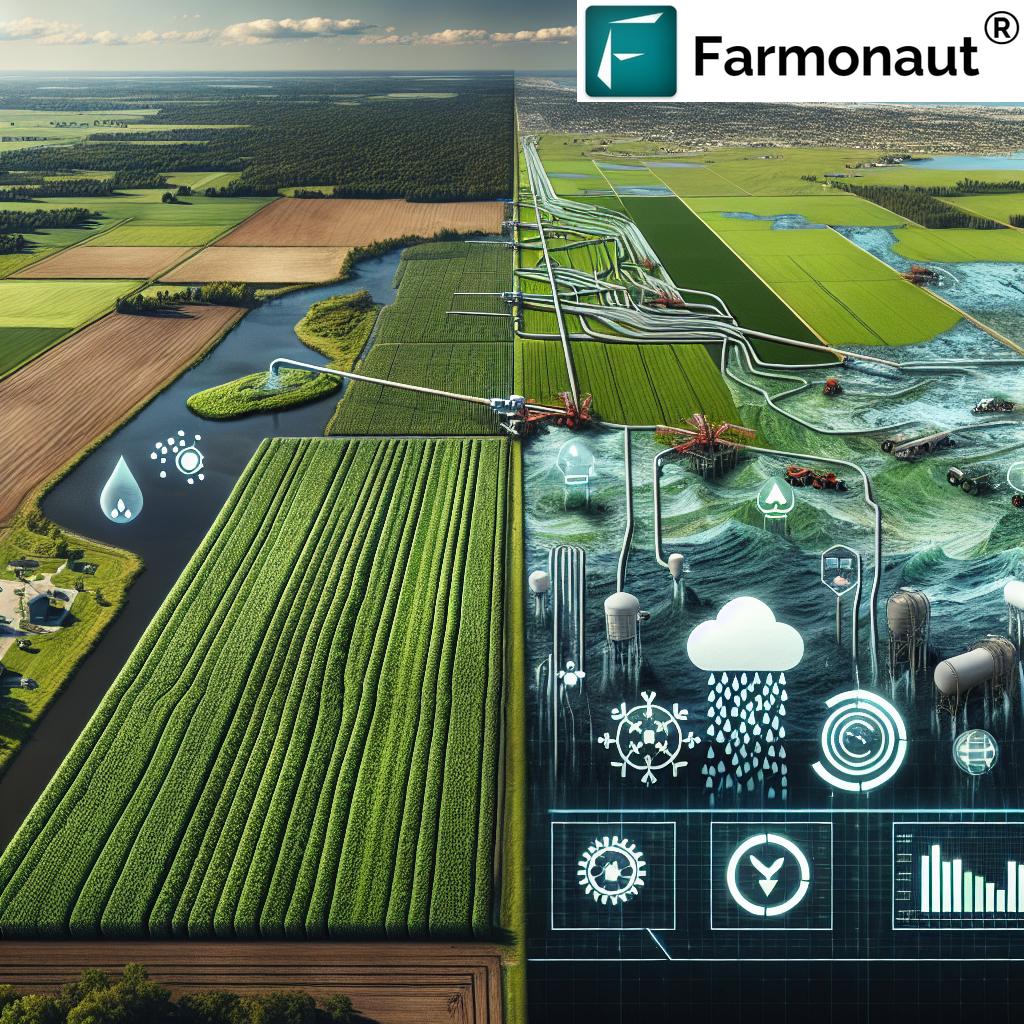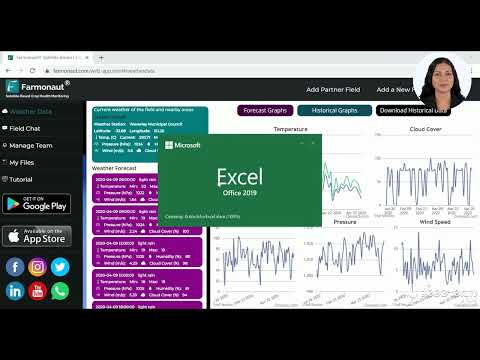Climate-Resilient Farming: How Ontario Farmers Can Adapt to Extreme Rainfall Trends
“Ontario experiences fewer rainy days overall, but extreme rainfall events have increased by 35% in recent decades.”
As we delve into the changing landscape of agriculture in Ontario, it’s crucial to understand the profound impact that climate change is having on our farming communities. At Farmonaut, we’re committed to providing innovative solutions to help farmers navigate these challenging times. Our satellite-based crop monitoring technology and AI-driven advisory systems are designed to empower farmers with the tools they need to adapt to evolving weather patterns.

Understanding the Shifting Precipitation Patterns in Ontario
Climate change is dramatically altering precipitation patterns across Canada, with Ontario experiencing significant shifts in rainfall trends. Despite a decrease in the overall number of rainy days, the province is witnessing an alarming increase in extreme weather events, particularly heavy rainfall. This paradoxical situation poses unique challenges for Ontario’s agricultural sector and infrastructure.
- Fewer rainy days overall
- Increased frequency of extreme rainfall events
- Higher intensity of precipitation during heavy rains
- Seasonal shifts in rainfall patterns
These changes are not just statistical anomalies; they have real-world implications for farmers, crop yields, and the entire agricultural ecosystem. The increase in heavy rainfall events is particularly concerning, as it can lead to soil erosion, nutrient leaching, and crop damage.
The Impact of Extreme Rainfall on Ontario Agriculture
The agricultural sector in Ontario is feeling the brunt of these changing weather patterns. Extreme rainfall events can have devastating effects on crops, soil health, and farm infrastructure. Here’s how these trends are impacting Ontario farmers:
- Soil Erosion: Heavy rains can wash away topsoil, depleting farmlands of essential nutrients.
- Crop Damage: Excessive moisture can lead to root rot, fungal diseases, and reduced crop quality.
- Delayed Planting: Wet conditions in spring can push back planting dates, shortening the growing season.
- Infrastructure Stress: Existing drainage systems and flood defenses may be overwhelmed by intense rainfall.
- Increased Operational Costs: Farmers may need to invest in additional drainage and erosion control measures.
To address these challenges, we at Farmonaut have developed advanced weather monitoring technology for farms. Our satellite-based systems provide real-time data on precipitation, soil moisture, and crop health, allowing farmers to make informed decisions and implement timely interventions.
Adapting to Changing Weather Patterns: Strategies for Ontario Farmers
In the face of these climate challenges, Ontario farmers must adopt new strategies to ensure the resilience and productivity of their operations. Here are some key approaches to consider:
- Improved Drainage Systems: Invest in enhanced drainage infrastructure to manage excess water effectively.
- Soil Conservation Practices: Implement cover cropping, no-till farming, and other soil health practices to reduce erosion and improve water retention.
- Crop Diversification: Introduce a variety of crops with different water requirements to spread risk.
- Weather-Resistant Crop Varieties: Select and plant crop varieties that are more tolerant to excess moisture and variable weather conditions.
- Precision Agriculture: Utilize technology like Farmonaut’s satellite monitoring to optimize resource use and respond quickly to changing conditions.
By embracing these adaptive strategies, Ontario farmers can better position themselves to thrive in the face of evolving precipitation trends and extreme weather impacts.
Leveraging Technology for Climate-Resilient Farming
At Farmonaut, we believe that technology plays a crucial role in helping farmers adapt to climate variability. Our suite of tools is designed to provide farmers with actionable insights to navigate the challenges posed by extreme weather events:
- Satellite-Based Crop Monitoring: Our advanced satellite imagery allows farmers to track crop health and soil moisture levels in real-time.
- AI-Powered Weather Forecasting: Our Jeevn AI advisory system delivers personalized weather forecasts and crop management strategies.
- Data-Driven Decision Making: By analyzing historical and real-time data, farmers can make informed decisions about planting, irrigation, and harvesting.
These technological solutions are not just about managing current conditions; they’re about preparing for the future of farming in a changing climate.
Explore Farmonaut’s API for advanced weather data integration
The Economic Impact of Extreme Rainfall on Ontario Agriculture
The economic implications of extreme rainfall trends for Ontario’s agricultural sector are significant. Farmers are facing increased costs associated with:
- Implementing new drainage systems
- Repairing flood damage to fields and infrastructure
- Potential crop losses due to excessive moisture
- Investing in climate-resilient technologies and practices
However, these investments in climate adaptation can lead to long-term benefits, including improved crop yields, reduced risk of catastrophic losses, and increased farm resilience.
“A mere 10% increase in heavy rainfall can lead to a 50% rise in crop damage, highlighting the need for climate-resilient farming practices.”
Government Support and Policy Implications
Adapting to climate change requires a collaborative effort between farmers, technology providers like Farmonaut, and government bodies. The Ontario government and various Canadian agencies are increasingly recognizing the need for support in this area:
- Funding for climate-resilient infrastructure projects
- Research grants for developing weather-resistant crop varieties
- Incentives for adopting sustainable farming practices
- Enhanced weather monitoring and early warning systems
These initiatives aim to help Ontario farmers build resilience against the challenges posed by extreme rainfall and other climate-related risks.

Sustainable Agriculture Practices for a Changing Climate
As we face the reality of climate change, sustainable agriculture practices become more critical than ever. Ontario farmers can adopt several strategies to enhance their farm’s sustainability and resilience:
- Agroforestry: Integrating trees and shrubs into crop and animal farming systems to improve water management and soil health.
- Conservation Tillage: Minimizing soil disturbance to maintain organic matter and reduce erosion.
- Precision Irrigation: Using data-driven approaches to optimize water use and reduce waste.
- Crop Rotation: Implementing diverse crop rotations to improve soil structure and reduce pest pressures.
- Green Infrastructure: Developing natural systems like wetlands and buffer strips to manage water flow and filter runoff.
These practices not only help farms withstand extreme weather events but also contribute to overall environmental health and long-term agricultural sustainability.
The Role of Data in Climate-Resilient Farming
In the era of precision agriculture, data plays a pivotal role in helping farmers adapt to changing weather patterns. At Farmonaut, we emphasize the importance of data-driven decision-making:
- Historical Weather Analysis: Understanding past trends to predict future patterns.
- Real-Time Monitoring: Utilizing satellite data to track current conditions across farm fields.
- Predictive Modeling: Employing AI and machine learning to forecast potential weather impacts on crops.
- Benchmarking: Comparing farm performance against regional averages to identify areas for improvement.
By leveraging these data sources, Ontario farmers can make more informed decisions about planting dates, crop selection, and resource allocation, ultimately building more resilient farming operations.
Check out our API Developer Docs for integrating weather data into your farm management systems
Innovative Flood Management Systems for Farms
As extreme rainfall events become more common, innovative flood management systems are crucial for protecting Ontario farms. Some cutting-edge approaches include:
- Smart Drainage Systems: Automated systems that adjust drainage based on real-time weather and soil moisture data.
- Retention Ponds: Strategically placed water bodies to capture and slowly release excess rainwater.
- Permeable Pavements: Surfaces that allow water to percolate through, reducing runoff and recharging groundwater.
- Bioswales: Vegetated channels designed to concentrate and convey stormwater runoff while removing debris and pollution.
These systems, when combined with Farmonaut’s advanced weather monitoring technology, can significantly enhance a farm’s resilience to heavy rainfall events.
The Future of Ontario Agriculture in a Changing Climate
As we look to the future, it’s clear that Ontario’s agricultural landscape will continue to evolve in response to changing precipitation patterns. Farmers who embrace innovation, sustainable practices, and technology-driven solutions will be best positioned to thrive in this new reality. At Farmonaut, we’re committed to supporting this transition with our cutting-edge satellite monitoring and AI-powered advisory services.
The future of farming in Ontario will likely see:
- Increased adoption of climate-resilient crop varieties
- More widespread use of precision agriculture technologies
- Greater integration of weather data in farm management decisions
- Continued innovation in water management and flood control systems
- Stronger collaborations between farmers, researchers, and technology providers
By staying ahead of these trends and leveraging the latest in agricultural technology, Ontario farmers can not only adapt to climate change but also lead the way in sustainable and resilient farming practices.
Empowering Ontario Farmers with Farmonaut’s Solutions
At Farmonaut, we understand the unique challenges faced by Ontario farmers in the wake of changing precipitation patterns. Our suite of tools is designed to provide farmers with the insights they need to make informed decisions and build resilience against extreme weather events:
- Real-Time Crop Monitoring: Our satellite-based technology provides up-to-date information on crop health, allowing for quick responses to changing conditions.
- Personalized Weather Forecasts: Our AI-driven system delivers tailored weather predictions, helping farmers plan their activities with greater precision.
- Soil Moisture Analysis: By tracking soil moisture levels, we help farmers optimize irrigation and drainage strategies.
- Historical Data Analysis: Our platform allows farmers to analyze past weather and crop performance data to inform future decision-making.
By leveraging these tools, Ontario farmers can better prepare for and respond to the challenges posed by extreme rainfall and other climate-related risks.
Ontario Rainfall Trends and Agricultural Adaptation Strategies
| Time Period | Average Annual Rainfall (mm) | Number of Heavy Rainfall Events per Year | Agricultural Challenges | Recommended Adaptation Strategies |
|---|---|---|---|---|
| 1980-2000 | 800 | 5 | Occasional flooding, moderate soil erosion | Traditional drainage systems, crop rotation |
| 2000-2020 | 850 | 8 | Increased flooding, soil erosion, crop damage | Improved drainage, cover crops, no-till farming |
| 2020-Present | 900 | 12 | Severe flooding, significant soil loss, crop failures | Smart drainage systems, precision agriculture, climate-resistant crops |
Conclusion: Building a Resilient Agricultural Future for Ontario
As we navigate the challenges posed by changing precipitation patterns and extreme rainfall events in Ontario, it’s clear that adaptation and innovation are key to the future of agriculture in the region. By embracing sustainable practices, leveraging advanced technologies, and staying informed about evolving weather trends, Ontario farmers can build resilience and continue to thrive in the face of climate change.
At Farmonaut, we’re committed to supporting farmers through this transition with our cutting-edge satellite monitoring, AI-powered advisory systems, and data-driven insights. Together, we can create a more sustainable and climate-resilient agricultural sector in Ontario, ensuring food security and economic stability for generations to come.
FAQs
- Q: How are rainfall patterns changing in Ontario?
A: Ontario is experiencing fewer rainy days overall, but the frequency and intensity of extreme rainfall events have increased significantly in recent decades. - Q: What are the main challenges faced by Ontario farmers due to extreme rainfall?
A: The main challenges include soil erosion, crop damage, delayed planting, infrastructure stress, and increased operational costs. - Q: How can farmers adapt to changing weather patterns?
A: Farmers can adapt by improving drainage systems, implementing soil conservation practices, diversifying crops, using weather-resistant varieties, and adopting precision agriculture technologies. - Q: What role does technology play in climate-resilient farming?
A: Technology, such as Farmonaut’s satellite-based crop monitoring and AI-powered weather forecasting, helps farmers make data-driven decisions and respond quickly to changing conditions. - Q: Are there government support programs for climate adaptation in Ontario agriculture?
A: Yes, the Ontario government and Canadian agencies offer various support programs, including funding for climate-resilient infrastructure, research grants, and incentives for sustainable farming practices.






